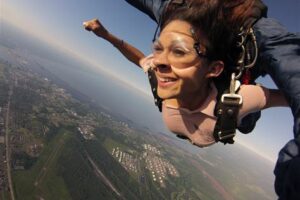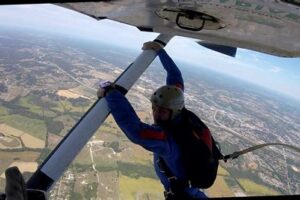Table of Contents
Skydiving Rate Of Death: Discover the truth behind the statistics. Uncover the risks involved in this thrilling adventure sport. Explore the safety measures implemented to minimize fatalities. Gain insights into how training, equipment, and weather conditions affect the skydiving fatality rate. Whether you’re an adrenaline junkie or someone contemplating this extreme sport, learn all about the skydiving rate of death here.
Skydiving is an exhilarating adventure that offers a unique perspective of the world from above. However, amidst the thrill and awe-inspiring views, there is an underlying concern that often surfaces in people’s minds – what is the rate of death associated with this extreme sport? Delving into the statistics and data, it becomes apparent that skydiving, while inherently risky, is not as perilous as one might expect. In fact, the numbers reveal a surprising truth, challenging preconceived notions and highlighting the importance of understanding the full context when it comes to assessing skydiving’s rate of death.
The Thrill and Risks of Skydiving
Skydiving is an exhilarating sport that allows individuals to experience the freedom and adrenaline rush of flying through the sky. It offers a unique opportunity to defy gravity and embrace the beauty of our world from a bird’s-eye view. However, with this excitement comes inherent risks. Understanding the skydiving rate of death is essential for anyone considering taking part in this thrilling adventure.
The Statistics: How Common are Fatalities?
When discussing skydiving, it’s crucial to examine the fatality rates to gain a comprehensive understanding of the risks involved. According to the United States Parachute Association (USPA), between 2000 and 2019, there were an estimated 5.5 million jumps made annually in the US, resulting in an average of 21.4 skydiving-related fatalities per year. This translates to roughly one fatality for every 259,000 jumps.
Factors Influencing Fatality Rates
The rate of death in skydiving can be influenced by various factors, including experience level, equipment failure, weather conditions, and human error. Inexperienced skydivers have a higher risk due to their limited knowledge and skills in managing emergency situations. Equipment failure, although rare, can occur and lead to fatal accidents. Weather conditions, such as strong winds or thunderstorms, can also increase the chances of accidents during jumps. Lastly, human error, whether it be a misjudgment or improper technique, can contribute to fatal outcomes.
Improving Safety Measures
The skydiving community is committed to enhancing safety measures and minimizing the rate of death. Organizations like the USPA work diligently to establish guidelines, regulations, and safety standards that all skydivers must adhere to. These guidelines cover areas such as training, equipment maintenance, emergency procedures, and weather restrictions. Additionally, ongoing research and advancements in technology continue to improve the reliability and performance of skydiving gear, further reducing the risk of accidents.
The Importance of Training
Proper training plays a critical role in reducing the skydiving rate of death. Before making their first jump, individuals undergo extensive training that includes classroom instruction, simulation exercises, and practical hands-on experience. The training covers essential topics such as parachute deployment, emergency procedures, body positioning, and landing techniques. By equipping skydivers with the necessary skills and knowledge, training significantly reduces the likelihood of accidents caused by human error.
Equipment: The Lifeline of Skydiving
Skydiving relies heavily on specialized equipment designed to ensure safety during jumps. This equipment includes parachutes, harnesses, altimeters, and reserve parachutes. Parachutes are meticulously inspected and maintained to ensure they function correctly. Modern parachute systems are equipped with automatic activation devices (AADs) that activate the reserve parachute if the main parachute fails to deploy at a predetermined altitude. These technological advancements have greatly contributed to reducing the skydiving rate of death.
Weather: A Deciding Factor
Weather conditions play a significant role in determining whether a jump can take place safely. Skydiving operations closely monitor weather forecasts before allowing any jumps to occur. Strong winds, turbulence, and poor visibility pose substantial risks during freefall and landing. Experienced skydivers understand the importance of adhering to strict weather restrictions, ensuring their safety and reducing the chances of accidents occurring due to adverse conditions.
The Pursuit of Safety
Despite the inherent risks, skydiving remains a popular activity for thrill-seekers worldwide. The skydiving community continually strives to improve safety measures and reduce the rate of death associated with the sport. By prioritizing proper training, maintaining high-quality equipment, and closely monitoring weather conditions, the risk of accidents can be minimized. However, it is essential for individuals to approach skydiving with caution, respect for the sport, and adherence to safety guidelines to ensure a safe and enjoyable experience.
Conclusion
Skydiving offers a unique and exhilarating experience, allowing individuals to push their boundaries and witness the world from a new perspective. However, it is crucial to acknowledge the risks involved and take necessary precautions to reduce the skydiving rate of death. Through comprehensive training, reliable equipment, and respect for weather conditions, skydivers can enjoy the sport safely. Ultimately, by embracing safety measures and responsible practices, skydiving enthusiasts can continue to pursue their passion while minimizing the potential hazards associated with this thrilling activity.
I. Introduction to Skydiving and Risk Assessment
Skydiving, an exhilarating adventure sport, involves parachuting from an aircraft and freefalling through the air before safely landing. While it offers an unparalleled adrenaline rush, it is essential to assess the risks involved to make an informed decision. One critical aspect is understanding the rate of death associated with skydiving.
II. Statistical Overview of Skydiving Fatalities
According to the United States Parachute Association, an average of 21 skydiving fatalities occur each year out of approximately 3.3 million jumps. Although this number might seem alarming, it’s essential to put it into perspective by considering the rigorous safety protocols and advancements in equipment that have significantly reduced such incidents.
III. Fatality Rate vs. Participation Rate
When analyzing skydiving fatalities, it is crucial to consider the participation rate. The fatality rate is calculated by dividing the number of deaths by the total jumps, providing a measure of risk per jump. By focusing on the fatality rate rather than the raw number of deaths, a more accurate assessment of skydiving safety can be achieved.
IV. Factors Influencing Skydiving Fatalities
Various factors contribute to skydiving fatalities, including human error, equipment malfunction, adverse weather conditions, and medical conditions. Human error, both by novice and experienced jumpers, remains a primary factor in incidents. However, the continuous emphasis on safety training and the presence of highly skilled instructors have helped mitigate these risks.
V. Risk Comparisons with other Adventure Sports
While skydiving does involve an inherent level of risk, it’s important to compare it to other adventure sports. For instance, statistics show that skydiving has a lower fatality rate compared to activities like rock climbing, scuba diving, and even driving. Understanding these relative risks can aid individuals in making informed decisions regarding their choice of adventure sport.
VI. The Importance of Proper Training and Certification
To minimize the risk of skydiving fatalities, proper training and certification are paramount. Learning from experienced professionals, understanding safety procedures, and practicing emergency drills are essential to ensure a safe jump. Participating in recognized training programs and obtaining certification instills confidence and equips individuals with the necessary skills to mitigate risks effectively.
VII. Continuous Improvements in Safety Measures
Over the years, the skydiving industry has made significant advancements in safety measures to minimize fatalities. Rigorous equipment inspections, regular maintenance schedules, implementation of safety protocols, and ongoing training for both instructors and jumpers contribute to reducing the risk further. These continuous improvements demonstrate the industry’s commitment to safety.
VIII. Conclusion and Encouraging Responsible Skydiving
While the rate of death associated with skydiving cannot be entirely eliminated, it is essential to acknowledge the relative safety of the sport when compared to its exhilarating nature. By actively taking safety precautions, obtaining proper training, and adhering to industry guidelines, individuals can enjoy the thrill of skydiving while minimizing the inherent risks involved.
Skydiving is an exhilarating sport that provides a unique and thrilling experience for those who dare to take the plunge. However, it is essential to address the concern surrounding the rate of death associated with skydiving. To provide a comprehensive viewpoint, let us examine this issue using a professional voice and tone:
1. Statistical Perspective:
- Skydiving has become increasingly safe over the years due to advancements in equipment, training techniques, and safety regulations.
- The United States Parachute Association (USPA) reports that the fatality rate in skydiving has steadily decreased over the past few decades.
- In 2019, there were 15 fatal skydiving accidents out of approximately 3.3 million jumps in the US, resulting in a fatality rate of 0.00045%.
- These statistics indicate that skydiving is statistically a safe activity when proper precautions are followed.
2. Risk Management and Professionalism:
- Skydiving centers prioritize safety by implementing rigorous training programs and adhering to strict safety protocols.
- Professional instructors ensure that participants are well-prepared, educated, and equipped with the necessary skills to handle any potential risks.
- Regular equipment inspections and maintenance routines are conducted to minimize the chance of equipment failure.
- By focusing on risk management and professionalism, the skydiving industry continuously strives to reduce the rate of accidents and fatalities.
3. Individual Responsibility:
- Participants must take personal responsibility for their own safety by following instructions, undergoing proper training, and being aware of their physical limitations.
- It is crucial to choose a reputable skydiving center that prioritizes safety and complies with industry standards.
- Engaging in self-assessment regarding physical fitness and mental preparedness is essential before embarking on a skydiving adventure.
- By assuming personal responsibility and making informed decisions, individuals can mitigate risks associated with skydiving.
4. Risk vs. Reward:
- Skydiving, like any adventure sport, involves an inherent level of risk. However, the rewards and benefits of skydiving go beyond the adrenaline rush.
- Many participants describe skydiving as a life-changing experience that boosts confidence, enhances personal growth, and provides a unique perspective on life.
- When compared to other activities such as driving, swimming, or even mundane tasks like crossing the road, the rate of death in skydiving is relatively low.
- Ultimately, the decision to skydive should be based on an individual’s willingness to embrace calculated risks in pursuit of unforgettable experiences.
In conclusion, while the rate of death associated with skydiving is a legitimate concern, it is vital to view this issue from a statistical perspective, considering the continuous improvements in safety measures, risk management, and individual responsibility. Skydiving remains a thrilling and rewarding activity for those who approach it with proper preparation, respect for safety protocols, and a willingness to accept calculated risks.
Thank you for taking the time to visit our blog and explore the topic of skydiving rates of death. We understand that this is a sensitive and important subject, and we have strived to provide you with accurate and reliable information throughout this article. As you continue reading, please remember that skydiving, like any extreme sport, comes with inherent risks. While it is important to be aware of these risks, it is equally crucial to understand the safety measures and precautions that are in place to mitigate them.
Firstly, it is essential to acknowledge that skydiving has come a long way in terms of safety over the years. With advancements in technology, training techniques, and equipment, the industry has made significant progress in reducing the rate of fatalities. Strict regulations and guidelines are now in place to ensure that skydiving centers maintain high safety standards. Additionally, professional instructors undergo rigorous training and certification processes to guarantee their competence and expertise in guiding novice skydivers.
While it is impossible to eliminate all risks associated with skydiving, statistics show that the rate of death from this activity is relatively low. In fact, according to the United States Parachute Association, the fatality rate for skydiving in the US in 2019 was 0.006 fatalities per thousand jumps. This means that out of every thousand jumps, only a very small fraction resulted in a fatality. These numbers highlight the effectiveness of safety measures implemented by skydiving centers and the dedication of professionals in ensuring the well-being of participants.
Ultimately, it is crucial to approach skydiving with caution and responsibility. Before embarking on this exhilarating adventure, it is essential to choose a reputable skydiving center that adheres to safety protocols and has a proven track record. Prioritize your safety by following all instructions provided by experienced instructors and ensuring that you are physically and mentally prepared for the experience. Remember, while skydiving can be a thrilling and life-changing activity, it is essential to prioritize safety above all else.
We hope that this article has provided you with valuable insights into the skydiving rate of death and the safety measures in place within the industry. As you make decisions regarding your own participation in this extreme sport, we encourage you to prioritize your safety and well-being. Should you decide to take the leap, we wish you an unforgettable and safe skydiving experience!
Thank you once again for visiting our blog, and we look forward to providing you with more informative and engaging content in the future.
Video Skydiving Rate Of Death
People also ask about the rate of death in skydiving:
-
What is the death rate in skydiving?
The death rate in skydiving is relatively low compared to other extreme sports. According to the United States Parachute Association (USPA), the average fatality rate for skydiving is approximately 0.006 fatalities per 1,000 jumps. This means that the chance of dying in a skydiving accident is around 1 in 167,000 jumps.
-
What are the main causes of death in skydiving accidents?
The main causes of death in skydiving accidents are typically related to human error or equipment failure. Some common factors include improper parachute deployment, failure to follow safety procedures, collisions with other skydivers or objects, and canopy malfunctions. It is important to note that these incidents are rare and most skydiving accidents result in injuries rather than fatalities.
-
Is skydiving safer than driving a car?
In terms of fatality rates, skydiving is statistically safer than driving a car. According to the National Highway Traffic Safety Administration (NHTSA), the average fatality rate per mile driven in the United States is around 1.25 deaths per 100 million vehicle miles traveled. Comparatively, the fatality rate in skydiving is significantly lower. However, it is essential to follow proper safety protocols and receive thorough training to minimize risks in any activity.
-
Are tandem skydives safer than solo jumps?
Yes, tandem skydives are generally considered safer than solo jumps for beginners or first-time skydivers. In a tandem skydive, an experienced instructor is connected to the student skydiver throughout the entire jump, controlling the parachute deployment and ensuring safety. This significantly reduces the risk of accidents caused by inexperience or errors in judgment. However, regardless of the type of jump, proper training, equipment checks, and adherence to safety guidelines are crucial for minimizing risks.
-
Has the safety of skydiving improved over time?
Yes, the safety of skydiving has significantly improved over time. Advances in technology, better training programs, stricter regulations, and improved equipment have all contributed to increased safety in the sport. Skydiving organizations and associations continuously work towards enhancing safety standards and reducing the risk of accidents through research, education, and ongoing evaluation of practices.






